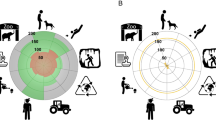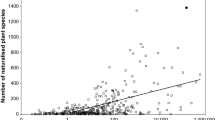Abstract
The article summarizes information on the penetration and spread of 14 most dangerous or potentially dangerous invasive species across the territory of Armenia, threatening natural biodiversity, natural ecosystems, and, to some extent, public health. It is shown that 8 out of 14 species were deliberately introduced into Armenia as ornamental plants or plants for landscaping of settlements and forest protection zones along roads and railways. At the same time, five of these species are arborous plants. Four species ended up on the territory of the republic as a result of their self-dispersal, and two species appeared as a result of unintentional introduction. The degree of threat to biodiversity and natural ecosystems is characterized as “high” for seven species and “very high” for four species, and three species are listed as “potentially invasive.” At the same time, one species (Ambrosia artemisiifolia) represents a “very high” threat to public health. The article proves the absolute necessity of conducting an examination on the threat of invasion when planning the introduction of plants in order to grow them in open ground, first of all, when creating plantations and using them in landscaping settlements and when creating or restoring damaged forest ecosystems and protective forest belts.




Similar content being viewed by others
REFERENCES
Abdieva, R.T., List of Invasive Flora of Azerbaijan, Baku, 2018.
Aleksanyan, A. and Fayvush, G., Using of GIS for the forecasting of distribution of invasive plants species in Armenia, in GIS and Remote Sensing. Proc. III Int. Conf. Tsahkadzor (Armenia), November 17–19, 2014, Yerevan, 2014, pp. 67–74.
Aleksanyan, A.S. and Ovannisyan, R.I., Distribution of invasive species Ambrosia artemisiifolia and Silybum marianum (Asteraceae) in Armenia, in Botanicheskaya nauka v sovremennom mire (Botanical Science in the Modern World), Yerevan: Inst. Botaniki Nats. Acad. Nauk Resp. Armeniya, 2015, pp. 177–182.
Aleksanyan, A. and Fayvush, G., Invasive alien plants species in Armenia: Main threats for natural ecosystems, Abstracts of European Workshop on Control and Eradication of Invasive Alien Plant Species, Budapest: Hungary, 2016, pp. 22–23.
Arevshatyan, I.G., Cirsium Mill., in Flora Armenii, Czech Republic: Koeltz Scientific Books, 1995, pp. 286–305.
Atasoy, V. and Corbaci, O.L., The invasive alien plants of Turkey: A checklist and environmental hazards, J. Appl. Environ. Biol. Sci., 2018, vol. 8, no. 5, pp. 1–8.
Bellard, C., Cassey, P., and Blackburn, T.M., Alien species as a driver of recent extinctions, Biol. Lett., 2015, vol. 12, no. 2, p. 0623. https://doi.org/10.1098/rsbl.2015.0623
CABI, Invasive Species Compendium. www.cabi.org/isc/ datasheet/2862. Cited April 29, 2022a.
CABI. Invasive Species Compendium www.cabi.org/isc/ datasheet/10314. Cited April 29, 2022b.
CABI, Invasive Species Compendium. www.cabi.org/isc/ datasheet/13628. Cited April 29, 2022c.
CABI, Invasive Species Compendium. www.cabi.org/isc/ datasheet/14280. Cited April 29, 2022d.
CABI, Invasive Species Compendium. www.cabi.org/isc/ datasheet/15251. Cited April 29, 2022e.
CABI, Invasive Species Compendium. www.cabi.org/isc/ datasheet/114634. Cited April 29, 2022f.
CABI, Invasive Species Compendium. www.cabi.org/isc/ datasheet/26716. Cited April 29, 2022g.
CABI, Invasive Species Compendium. www.cabi.org/isc/ datasheet/13357. Cited April 29, 2022h.
CABI, Invasive Species Compendium. www.cabi.org/isc/ datasheet/47698. Cited April 29, 2022i.
CABI, Invasive Species Compendium. www.cabi.org/isc/ datasheet/50304. Cited April 29, 2022j.
CABI, Invasive Species Compendium. www.cabi.org/isc/ datasheet/50599. Cited April 29, 2022k.
Cacabelos, E., Martins, G.M., Faria, J., Prestes, A.C.L., Costa, T., Moreu, I., and Neto, A.I., Limited effects of marine protected areas on the distribution of invasive species, despite positive effects on diversity in shallow-water marine communities, Biol. Invasions, 2020, vol. 22, no. 3, pp. 1169–1179. https://doi.org/10.1007/s10530-019-02171-x
Dehshiri, M.M., Invasive alien species of Iran, in Invasive Alien Species: Observations and Issues from Around the World, Pullaiah, T. and Lelmini, M.R., Eds., 2021, vol. 2, pp. 103–125.
Essl, F., Bacher, S., Blackburn, T.M., Booy, O., Brundu, G., Brunel, S., Cardoso, A.-C., Eschen, R., Gallardo, B., Galil, B., Garcia-Berthou, E., Genovesi, P., Groom, Q., Harrower, C., Hulme, P.E., Katsanevakis, S., Kenis, M., Kuhn, I., Kumschick, S., … and Jeschke, J.M., Crossing frontiers in tackling pathways of biological invasions, BioScience, 2015, vol. 65, no. 8, pp. 769–782. https://doi.org/10.1093/biosci/biv082
Fayvush, G., Invasive plant species spreading strategy main types in Armenia, in Plant Evolution in Man-Made Habitats. Proc. 7th Int. IOPB Symp (Amsterdam, August 10–15, 1998), Raamsdonk, L.W.D. and Nijs, J.C.M., Eds., Amsterdam: Univ. of Amsterdam, 1999, p. 74.
Fayvush, G., Investigation of invasive plant species in Armenia, in Neobiota: Towards a Synthesis. Abstr. 5th Eur. Conf. on Biol. Invasions (Prague, September 23–26, 2008), Prague, 2008, p. 72.
Fayvush, G.M. and Tamanyan, K.G., On the distribution of some invasive and expansive plant species in Armenia and the Caucasus, Takhtadzhyaniya, 2011, vol. 1, pp. 181–185.
Fayvush, G.M. and Tamanyan, K.G. Invazivnye i ekspansivnye vidy rastenii (Invasive and Expansive Plant Species), Yerevan: Inst. Botaniki Nats. Acad. Nauk Resp. Armeniya, 2014.
Fayvush, G.M., Aleksanyan, A.S., and Ovannisyan, R.I., Some new data on the distribution of invasive plant species in Armenia, Bot. Vestn. Sev. Kavkaza, 2015, vol. 2, pp. 62–73.
Fayvush, G., Vardanyan, Zh., and Aleksanyan, A., Invasiveness risk assessment of woody plants of Armenia, Thaiszia—J. Bot., 2018, vol. 28, no. 2, pp. 81–91.
Fayvush, G., Aleksanyan, A., and Hovhannisyan, H., Aggressive Plants. The Most Important Invasive and Expanding Plants of Armenia, Yerevan: Inst. of Botany Natl. Acad. of Sci. of the Republic of Armenia, 2020.
Gabrielyan, E.Ts. and Tamanyan K.G., New genus and rare species from the flora of Armenia, Biol. Zh. Arm., 1985, vol. 38, no. 2, pp. 164–166.
Gabrielyan, E.Ts., Timukhin, I.N., Tuniev, B.S., and Agababyan, M.V., New invasive genus Grindelia (Asteraceae) from Armenia and new localities from Northwestern and Western Transcaucasia, Takhtadzhyaniya, 2016, vol. 3, pp. 130–132.
Hulme, P.E., Trade, transport and trouble: managing invasive species pathways in an era of globalization, J. Appl. Ecol., 2009, vol. 46, no. 1, pp. 10–18. https://doi.org/10.1111/j.1365-2664.01600.x
IPBES. The IPBES Regional Assessment Report on Biodiversity and Ecosystem Services for Europe and Central Asia, Secretariat of the Intergovernmental Science-Policy Platform on Biodiversity and Ecosystem Services, 2018. https://doi.org/10.5281/ZENODO.3237429
Jinjolia, L. and Shakarishvili, N., Grindelia squarrosa (Rursh) Dunal—a new alien genus and species for flora of Georgia, Bull. Georgian Natl. Acad. Sci., 2014, vol. 8, no. 3, pp. 64–68.
Kikodze, D., Memiadze, N., Kharazishvili, D., Manvelidze, Z., and Mueller-Schaerer, H., The Alien Flora of Georgia, Tbilisi, 2009.
Litvinskaya, S.A. and Abdyeva R.T., Cereal fraction of the invasive flora of the Caucasus, Yug Ross.: Ekol. Razvit., 2021, vol. 16, pp. 56–70.
Liu, X., McGarrity, M.E., and Li, Y., The influence of traditional Buddhist wildlife release on biological invasions: religious release promotes species invasions, Conserv. Lett., 2012, vol. 5, no. 2, pp. 107–114.https://doi.org/10.1111/j.1755-263X.2011.00215.x
Liu, X., Blackburn, T.M., Song, T., Wang, X., Huang, C., and Li, Y., Animal invaders threaten protected areas worldwide, Nat. Commun., 2020, vol. 11, no. 1, p. 2892.https://doi.org/10.1038/s41467-020-16719-2
Ovannisyan, R.I., Distribution of two invasive species in Armenia and the degree of threat to the ecosystems of the Ecological Network “Emerald,” Takhtadzhyaniya, 2018, vol. 4, pp. 77–80.
Pipek, P., Blackburn, T.M., Delean, S., Cassey, P., Şekercioğlu, Ç.H., and Pyšek, P., Lasting the distance: the survival of alien birds shipped to New Zealand in the 19th century, Ecol. Evol., 2020, vol. 10, no. 9, pp. 3944–3953. https://doi.org/10.1002/ece3.6143
Pyšek, P., Hulme, P.E., Simberloff, D., Bacher, S., Blackburn, T.M., Carlton, J.T., Dawson, W., Essl, F., Foxcroft, L.C., Genovesi, P., Jeschke, J.M., Kühn, I., Liebhold, A.M., Mandrak, N.E., Meyerson, L.A., Pauchard, A., Pergl, J., Roy, H.E., Seebens, H., and Richardson, D.M., Scientists’warning on invasive alien species, Biol. Rev., 2020, vol. 95, no. 6, pp. 1511–1534. https://doi.org/10.1111/brv.12627
Saul, W.-C., Roy, H.E., Booy, O., Carnevali, L., Chen, H.-J., Genovesi, P., Harrower, C.A., Hulme, P.E., Pagad, S., Pergl, J., and Jeschke, J.M., Assessing patterns in introduction pathways of alien species by linking major invasion data bases, J. Appl. Ecol., 2017, vol. 54, no. 2, pp. 657–669. https://doi.org/10.1111/1365-2664.12819
Seebens, H., Blackburn, T.M., Dyer, E.E., Genovesi, P., Hulme, P.E., Jeschke, J.M., Pagad, S., Pyšek, P., Winter, M., Arianoutsou, M., Bacher, S., Blasius, B., Brundu, G., Capinha, C., Celesti-Grapow, L., Dawson, W., Dullinger, S., Fuentes, N., Jager, H., and Essl, F., No saturation in the accumulation of alien species worldwide, Nat. Commun., 2017, vol. 8, no. 1, p. 14435.https://doi.org/10.1038/ncomms14435
Takhtadzhyan, A.L., Map of the flora regions of the Armenian SSR, in Flora Armenii (Flora of Armenia), Yerevan: Akad. Nauk Armyanskoi SSR, 1954, vol. 1, p. 3.
Tamanyan, K.G. and Faivush, G.M., On the issue of floristic zoning of Armenia, in Flora, rastitel’nost’ i rastitel’nye resursy Armenii (Flora, Vegetation and Plant Resources of Armenia), Yerevan: Inst. Botaniki Nats. Acad. Nauk Resp. Armeniya, 2009, vol. 17, pp. 73–78.
The Red Data Book of Plants of Armenia, Tamanyan, K.G., Fayvush, G.M., Nanagyulyan, S.G., and Danielyan, T.S., Eds., Yerevan: Ministry of Nature protection of Republic of Armenia, 2010.
Wilson, J.R.U., Dormontt, E.E., Prentis, P.J., Lowe, A.J., and Richardson, D.M., Something in the way you move: Dispersal pathways affect invasion success, Trends Ecol. Evol., 2009, vol. 24, no. 3, pp. 136–144.https://doi.org/10.1016/j.tree.2008.10.007
Funding
The study was carried out with the financial support of the Science Committee of the Republic of Armenia within the framework of the scientific project no. 21AG-1F004.
Author information
Authors and Affiliations
Corresponding authors
Ethics declarations
Conflict of interest. The authors declare that they have no conflicts of interest.
Statement of the welfare of humans or animals. The article does not contain any studies involving humans or animals in experiments performed by any of the authors.
Additional information
Translated by M. Shulskaya
Rights and permissions
About this article
Cite this article
Fayvush, G.M., Aleksanyan, A.S. & Hovhannisyan, H.I. Invasion Vectors and Distribution of Some Invasive Plant Species in Armenia. Russ J Biol Invasions 13, 350–360 (2022). https://doi.org/10.1134/S2075111722030043
Received:
Revised:
Accepted:
Published:
Issue Date:
DOI: https://doi.org/10.1134/S2075111722030043




